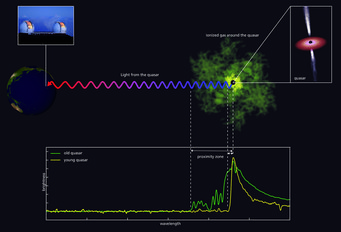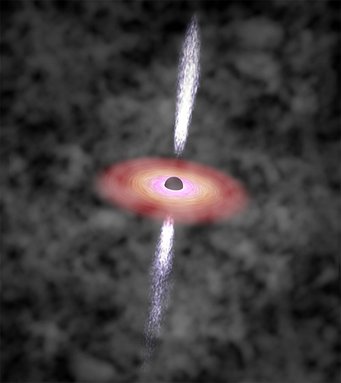Discovery in the early universe poses black hole growth puzzle
Quasars are luminous objects with supermassive black holes at their centers, visible over vast cosmic distances. Infalling matter increases the black hole mass and is also responsible for a quasar's brightness. Now, using the W.M. Keck observatory in Hawaii, astronomers led by Christina Eilers have discovered extremely young quasars with a puzzling property: these quasars have the mass of about a billion suns, yet have been collecting matter for less than 100,000 years. Conventional wisdom says quasars of that mass should have needed to pull in matter a thousand times longer than that – a cosmic conundrum. The results have been published in the May 2 edition of the Astrophysical Journal.
| Background information | Download area | In-depth description of the results |

Within the heart of every massive galaxy lurks a supermassive black hole. How these black holes formed, and how they have grown to be as massive as millions or even billions of suns, is an open question. At least some phases of vigorous growth are highly visible to astronomical observers: Whenever there are substantial amounts of gas swirling into the black hole, matter in the direct vicinity of the black hole emits copious amount of light. The black hole has intermittently turned into a quasar, one of the most luminous objects in the universe.
Now, researchers from the Max Planck Institute for Astronomy (MPIA) have discovered three quasars that challenge conventional wisdom on black hole growth. These quasars are extremely massive, but should not have had sufficient time to collect all that mass. The discovery, which is based on observations at the W.M. Keck observatory in Hawaii, glimpses into ancient cosmic history: Because of their extreme brightness, quasars can be observed out to large distances. The astronomers observed quasars whose light took nearly 13 billion years to reach Earth. In consequence, the observations show these quasars not as they are today, but as they were almost 13 billion years ago, less than a billion years after the big bang.
The quasars in question have about a billion times the mass of the sun. All current theories of black hole growth postulate that, in order to grow that massive, the black holes would have needed to collect infalling matter, and shine brightly as quasars, for at least a hundred million years. But these three quasars proved to be have been active for a much shorter time, less than 100,000 years. “This is a surprising result,” explains Christina Eilers, a doctoral student at MPIA and lead author of the present study. “We don’t understand how these young quasars could have grown the supermassive black holes that power them in such a short time.”
To determine how long these quasars had been active, the astronomers examined how the quasars had influenced their environment – in particular, they examined heated, mostly transparent “proximity zones” around each quasar. “By simulating how the light from quasars ionizes and heats gas around them, we can predict how large the proximity zone of each quasar should be,” explains Frederick Davies, a postdoctoral researcher at MPIA who is an expert in the interaction between quasar light and intergalactic gas. Once the quasar has been “switched on” by infalling matter, these proximity zones grow very quickly. “Within a lifetime of 100,000 years, quasars should already have large proximity zones.”
Surprisingly, three of the quasars had very small proximity zones – indicating that the active quasar phase cannot have set in more than 100,000 years earlier. “No current theoretical models can explain the existence of these objects,” says Professor Joseph Hennawi, who leads the research group at MPIA that made the discovery. “The discovery of these young objects challenges the existing theories of black hole formation and will require new models to better understand how black holes and galaxies formed.“
The astronomers have already planned their next steps. “We would like to find more of these young quasars,“ says Christina Eilers, “While finding these three unusual quasars might have been a fluke, finding additional examples would imply that a significant fraction of the known quasar population is much younger than expected.” The scientists have already applied for telescope time to observe several additional candidates. The results, they hope, will constrain new theoretical models about the formation of the first supermassive black holes in the universe – and, by implication, help astronomers understand the history of the giant supermassive black holes at the center of present-day galaxies like our own Milky Way.
Background information
The work described here has been published as A. C. Eilers, "Implications of z ∼ 6 Quasar Proximity Zones for the Epoch of Reonisation and Quasar Lifetimes" in the May 2 edition of the Astrophysical Journal.
The MPIA researchers involved are
Anna-Christina Eilers, Frederick B. Davies, Joseph F. Hennawi, (also University of California at Santa Barbara), and Chiara Mazzucchelli
in collaboration with
J. Xavier Prochaska (University of California, Santa Cruz) and Zarija Lukic (Lawrence Berkeley National Laboratory).
Both A. C. Eilers and C. Mazzuchelli are members of the International Max Planck Research School for Astronomy and Cosmic Physics at the University of Heidelberg.
Additional figures and download

Figure 1



